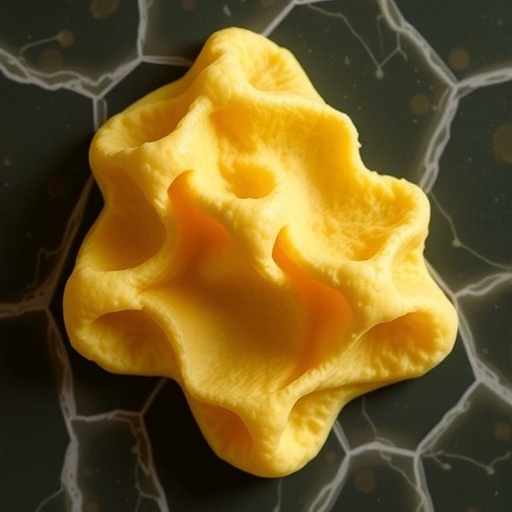In the dynamic landscape of food science, the quest for innovative texturizing agents and delivery systems has led researchers to explore complex gel matrices known as bigels. These intriguing combinations of oleogels and hydrogels hold immense potential in reshaping how we think about edible materials, encapsulating flavors or nutrients, and improving food stability. In a pioneering study published in Food Science and Biotechnology, Hernández-Nolasco and colleagues delve deep into the structural and functional properties of beeswax–taro starch-based bigels, meticulously analyzing how varying the oleogel to hydrogel ratio affects their performance and potential applications.
Bigels emerge from the amalgamation of two gel types with distinct phases: an oleogel with a predominantly oil phase structured by a gelator, and a hydrogel that consists of a water-based polymer network. Each gel type offers unique characteristics, but when combined in strategic ratios, they result in hybrid materials with synergistically enhanced functionality. In this research, beeswax serves as the oleogelator, a natural wax prized for its biocompatibility and food-grade status, while taro starch is employed as the hydrogel matrix, tapping into its biodegradable and sustainable properties.
The focal point of this investigation is the intricate balance between oleogel and hydrogel phases—a ratio that fundamentally dictates bigel texture, rheological properties, water retention, and mechanical stability. By experimenting with incremental changes in this ratio, the authors sought to elucidate how these proportional shifts influence not only the microstructure but also the macroscopic behavior critical for food applications, such as spreadability, firmness, and thermal stability.
Using advanced microscopy techniques, the team observed that increasing the oleogel fraction fosters a denser, more interconnected wax crystal network within the fat phase, effectively reinforcing the bigel matrix. Conversely, elevating the hydrogel proportion induces greater hydration and elasticity, attributed to the swelling behavior of taro starch granules within the aqueous phase. This dichotomy manifests as a tunable textural landscape, allowing customization of bigel properties according to targeted culinary or pharmaceutical uses.
Rheological testing unveiled vital insights into bigel viscoelasticity—parameters that significantly influence mouthfeel and processing behavior. The results indicated that higher oleogel ratios contribute to enhanced storage modulus values, signifying stiffer gels with greater energy storage capacity. Such stiffening is particularly advantageous in formulations where structural integrity under shear stress is paramount, for instance, in fat replacers or controlled-release matrices.
Water retention properties emerged as another critical aspect of the study, underlying the shelf life and sensory attributes of bigels. As hydrogels are inherently hydrophilic, their proportion directly impacts moisture content within the system. Remarkably, the study found that a balanced oleogel:hydrogel ratio facilitates optimal water holding, mitigating syneresis and phase separation, which are common issues plaguing mixed gel systems.
The thermal behavior of these bigels further accentuates their application potential. Differential scanning calorimetry results revealed that the melting point range and crystallization patterns shift with oleogel concentration, influenced by the beeswax’s polymorphic nature. Such thermal tunability enables the design of bigels resilient to varying storage and processing temperatures, enhancing their versatility across different food product categories.
From a functional standpoint, the integration of beeswax and taro starch not only synergizes their individual properties but also introduces new modalities of nutrient and bioactive delivery. The hydrophobic domains of beeswax encapsulate lipid-soluble compounds, while the hydrogel matrix can harbor water-soluble ingredients. This dual-phase architecture positions bigels as promising carriers for complex, multi-compound formulations in the nutraceutical sector.
The study also addressed the sensory and stability implications of varying bigel compositions. Sensory descriptors such as spreadability, adhesiveness, and firmness were significantly modulated by the oleogel:hydrogel balance, implying the ability to tailor product characteristics to consumer preferences. Stability analyses demonstrated minimal phase separation over time, particularly in bigels with intermediate oleogel content, underscoring their robustness.
Environmental and sustainability considerations underscore the significance of using beeswax and taro starch. Both components are biodegradable, renewable, and relatively abundant, aligning with current trends towards eco-friendly food ingredients. The capacity to engineer bigels with natural materials paves the way for developing clean-label products that can satisfy both industrial performance and consumer demand for transparency and sustainability.
Emerging applications for beeswax–taro starch bigels span from novel fat replacers in bakery and confectionery to innovative encapsulation media for vitamin delivery. Their controllable texture and phase behavior could revolutionize how fats are incorporated into food matrices, potentially reducing saturated fat content while maintaining sensory quality. Moreover, these bigels’ potential as carriers in cosmetic and pharmaceutical formulations further broadens their impact beyond the culinary realm.
Technological implications extend into manufacturing processes where bigels can offer enhanced stability under varying shear and thermal conditions. The ease of modulating their viscoelastic properties by simple ratio adjustments minimizes the need for complex additive combinations, streamlining product development and scalability—a crucial factor for industrial adoption.
Critically, the research underscores the interplay between microstructure and macroscopic performance, highlighting the importance of detailed characterization to understand and predict how composite gels behave under real-world conditions. This fundamental knowledge bridges the gap between conceptual formulations and their functional implementation in products encountered daily by consumers.
In conclusion, the investigation into beeswax–taro starch-based bigels delivers transformative insights, showcasing how natural, sustainable ingredients can be harnessed to engineer multifunctional gels with customizable properties. By finely tuning the oleogel:hydrogel ratio, manufacturers can produce bigels tailored for diverse applications, ranging from texture modifiers to sophisticated nutrient delivery systems. This work sets the scientific and practical groundwork for future innovation in food technology and material science, positioning bigels at the forefront of next-generation functional food ingredients.
Subject of Research: Structural and functional properties of beeswax–taro starch-based bigels and the effect of varying oleogel to hydrogel ratios.
Article Title: Structural and functional properties of beeswax–taro starch-based bigels: effect of the oleogel:hydrogel ratio.
Article References:
Hernández-Nolasco, Z., Acateca-Hernández, M.I., Rojas-López, M. et al. Structural and functional properties of beeswax–taro starch-based bigels: effect of the oleogel:hydrogel ratio. Food Sci Biotechnol (2025). https://doi.org/10.1007/s10068-025-01961-5
Image Credits: AI Generated




